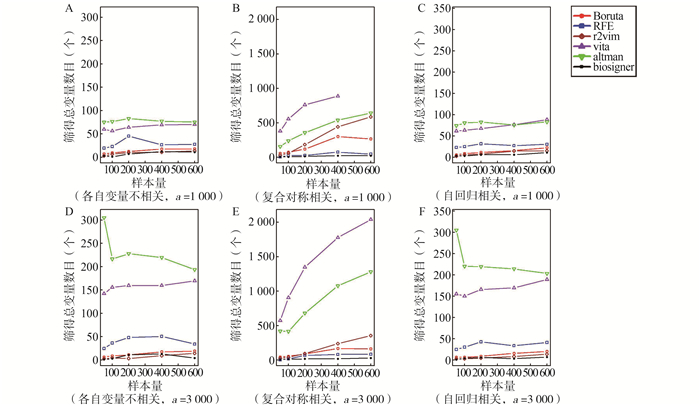| [1] |
Kohavi R, John GH. Wrappers for feature subset selection[J]. Artif Intell, 1997, 97(1-2): 273-324. DOI: 10.1016/S0004-3702(97)00043-X.
|
| [2] |
Tang YC, Zhang YQ, Huang Z. Development of two-stage SVM-RFE gene selection strategy for microarray expression data analysis[J]. IEEE/ACM Trans Comput Biol Bioinform, 2007, 4(3): 365-381. DOI: 10.1109/TCBB.2007.70224.
|
| [3] |
Stańczyk U, Jain LC. Feature selection for data and pattern recognition[M]. Berlin: Springer, 2015: 12-14.
|
| [4] |
Nilsson R, Peña JM, Björkegren J, et al. Detecting multivariate differentially expressed genes[J]. BMC Bioinformatics, 2007, 8: 150. DOI: 10.1186/1471-2105-8-150.
|
| [5] |
Ein-Dor L, Kela I, Getz G, et al. Outcome signature genes in breast cancer: is there a unique set?[J]. Bioinformatics, 2005, 21(2): 171-178. DOI: 10.1093/bioinformatics/bth469.
|
| [6] |
张鼎, 赵亚双. 生物信息学在分子流行病学中的应用[J]. 中华疾病控制杂志, 2021, 25(1): 20-24. DOI: 10.16462/j.cnki.zhjbkz.2021.01.005.Zhang D, Zhao YS. Applications of bioinformatics in molecular epidemiology[J]. Chin J Dis Control Prev, 2021, 25(1): 20-24. DOI: 10.16462/j.cnki.zhjbkz.2021.01.005.
|
| [7] |
Breiman L. Random forests[J]. Mach Learn, 2001, 45(1): 5-32. DOI: 10.1023/A:1010933404324.
|
| [8] |
Nicodemus KK, Malley JD, Strobl C, et al. The behaviour of random forest permutation-based variable importance measures under predictor correlation[J]. BMC Bioinformatics, 2010, 11: 110. DOI: 10.1186/1471-2105-11-110.
|
| [9] |
Degenhardt F, Seifert S, Szymczak S. Evaluation of variable selection methods for random forests and omics data sets[J]. Brief Bioinform, 2019, 20(2): 492-503. DOI: 10.1093/bib/bbx124.
|
| [10] |
Wu XY, Wu ZY, Li K. Identification of differential gene expression for microarray data using recursive random forest[J]. Chin Med J (Engl), 2008, 121(24): 2492-2496. DOI: 10.3238/arztebl.2008.0900a.
|
| [11] |
Rinaudo P, Boudah S, Junot C, et al. Biosigner: a new method for the discovery of significant molecular signatures from omics data[J]. Front Mol Biosci, 2016, 3: 26. DOI: 10.3389/fmolb.2016.00026.
|
| [12] |
Kursa MB, Jankowski A, Rudnicki WR. Boruta-a system for feature selection[J]. Fundam Informaticae, 2010, 101(4): 271-285. DOI: 10.3233/fi-2010-288.
|
| [13] |
Altmann A, Toloşi L, Sander O, et al. Permutation importance: a corrected feature importance measure[J]. Bioinformatics, 2010, 26(10): 1340-1347. DOI: 10.1093/bioinformatics/btq134.
|
| [14] |
Szymczak S, Holzinger E, Dasgupta A, et al. r2VIM: a new variable selection method for random forests in genome-wide association studies[J]. BioData Min, 2016, 9: 7. DOI: 10.1186/s13040-016-0087-3.
|
| [15] |
Janitza S, Celik E, Boulesteix AL. A computationally fast variable importance test for random forests for high-dimensional data[J]. Adv Data Anal Classif, 2018, 12(4): 885-915. DOI: 10.1007/s11634-016-0276-4.
|
| [16] |
Shin M, Bhattacharya A, Johnson VE. Scalable Bayesian variable selection using nonlocal prior densities in ultrahigh-dimensional settings[J]. Stat Sin, 2018, 28(2): 1053-1078. DOI: 10.5705/ss.202016.0167.
|
| [17] |
Yan WH, Jiang XN, Wang WG, et al. Cell-of-origin subtyping of diffuse large B-cell lymphoma by using a qPCR-based gene expression assay on formalin-fixed paraffin-embedded tissues[J]. Front Oncol, 2020, 10: 803. DOI: 10.3389/fonc.2020.00803.
|
| [18] |
Alizadeh AA, Eisen MB, Davis RE, et al. Distinct types of diffuse large B-cell lymphoma identified by gene expression profiling[J]. Nature, 2000, 403(6769): 503-511. DOI: 10.1038/35000501.
|
| [19] |
Reif DM, Motsinger-Reif AA, McKinney BA, et al. Integrated analysis of genetic and proteomic data identifies biomarkers associated with adverse events following smallpox vaccination[J]. Genes Immun, 2009, 10(2): 112-119. DOI: 10.1038/gene.2008.80.
|
| [20] |
Salzer U, Chapel HM, Webster AD, et al. Mutations in TNFRSF13B encoding TACI are associated with common variable immunodeficiency in humans[J]. Nat Genet, 2005, 37(8): 820-828. DOI: 10.1038/ng1600.
|
| [21] |
Kralickova P, Milota T, Litzman J, et al. CVID-associated tumors: Czech nationwide study focused on epidemiology, immunology, and genetic background in a cohort of patients with CVID[J]. Front Immunol, 2019, 9: 3135. DOI: 10.3389/fimmu.2018.03135.
|
| [22] |
Inamo J, Suzuki K, Takeshita M, et al. Identification of novel genes associated with dysregulation of B cells in patients with primary Sjögren's syndrome[J]. Arthritis Res Ther, 2020, 22(1): 153. DOI: 10.1186/s13075-020-02248-2.
|
| [23] |
Liu JQ, Yao YL, Hu ZY, et al. Transcriptional profiling of long-intergenic noncoding RNAs in lung squamous cell carcinoma and its value in diagnosis and prognosis[J]. Mol Genet Genomic Med, 2019, 7(12): e994. DOI: 10.1002/mgg3.994.
|
| [24] |
Blenk S, Engelmann J, Weniger M, et al. Germinal center B cell-like (GCB) and activated B cell-like (ABC) type of diffuse large B cell lymphoma (DLBCL): analysis of molecular predictors, signatures, cell cycle state and patient survival[J]. Cancer Inform, 2007, 3: 399-420. DOI: 10.1177/117693510700300004.
|
| [25] |
Wood O, Woo J, Seumois G, et al. Gene expression analysis of TIL rich HPV-driven head and neck tumors reveals a distinct B-cell signature when compared to HPV independent tumors[J]. Oncotarget, 2016, 7(35): 56781-56797. DOI: 10.18632/oncotarget.10788.
|
| [26] |
Coutinho R, Clear AJ, Owen A, et al. Poor concordance among nine immunohistochemistry classifiers of cell-of-origin for diffuse large B-cell lymphoma: implications for therapeutic strategies[J]. Clin Cancer Res, 2013, 19(24): 6686-6695. DOI: 10.1158/1078-0432.CCR-13-1482.
|





 下载:
下载:





